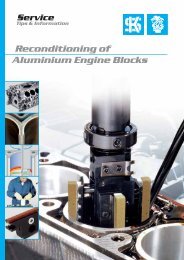ELECTROSIL COATED CYLINDERS
ELECTROSIL COATED CYLINDERS
ELECTROSIL COATED CYLINDERS
You also want an ePaper? Increase the reach of your titles
YUMPU automatically turns print PDFs into web optimized ePapers that Google loves.
<strong>ELECTROSIL</strong><br />
Now the Electrosil Coating<br />
Technology can be applied....<br />
Plating the cylinder is not just a simple<br />
process where the cylinder is dipped in a tank<br />
and then pulled out like paint, magically being<br />
recoated. The Electrosil process is an<br />
extremely complicated procedure similar to<br />
Electroplating where a negative and positive<br />
charge is applied to the job. This creates a<br />
potential difference that causes metal ions to<br />
flow to the cylinder surface and encapsulate<br />
microscopic particles of Silicon Carbide and<br />
other additives as used by Electrosil. It must<br />
also be pointed out at this stage there is a<br />
huge range of variables and pretreatment<br />
possibilities for all differing alloys to be coated.<br />
This is where the Australian owned and<br />
developed Electrosil process differs<br />
dramatically from the competition. Electrosil<br />
use only the best German materials and<br />
employ unique additives such as Electrolube<br />
and other components engineered into the<br />
coating to improve performance and durability.<br />
Our pretreatment system has been tested time<br />
and time again, providing the best adhesion<br />
possible. When performed correctly the bond<br />
strength between the coating and the alloy can<br />
exceed 25,000psi. We have also found over<br />
the years that many cylinder coating plants<br />
have developed their own unique methods of<br />
coating application and more notably that<br />
some tend to take short cuts when it comes to<br />
material quality and wear resistance. This is<br />
one of the main reasons other similar coatings<br />
wear out so fast, and how cheap, inferior<br />
cylinders can be manufactured.<br />
It must be pointed out that cylinder<br />
coating is not a five minute job, and requires<br />
expensive precision equipment not only to<br />
process the cylinders but also to deal with the<br />
toxic trade waste that is produced. The<br />
Electrosil process has been developed over<br />
the past 15 years not only to provide the best<br />
cylinder coating but to do so in an<br />
environmentally sound way. The coating<br />
system has been developed to be a closed<br />
system to minimize drag out of the Electrosil<br />
coating chemicals. Once the cylinder has been<br />
coated it is removed from the system and<br />
cleaned of any residual coating solution and<br />
contamination. The cylinder then must be<br />
rough ground through the port and skirt<br />
chamfers before it is placed in an oven and<br />
heat treated to increase the coating bond<br />
strength at the metal interface.<br />
Once treated it is removed cooled and<br />
then beadblasted to brighten up the alloy<br />
exterior.<br />
At this time the cylinder has been coated<br />
to an undersize of the piston and will require a<br />
specialized honing process to size the bore to<br />
the correct tolerances.<br />
Cylinder Coating Stages<br />
Top:<br />
Typical Damaged/worn<br />
cylinder<br />
Centre:<br />
Cylinder coating removed and<br />
precision honed ready for coating<br />
application.<br />
Bottom:<br />
Electrosil coating applied and<br />
diamond honed to finish bore size.<br />
Electrosil<br />
Coating Close<br />
Up!!<br />
[3]




